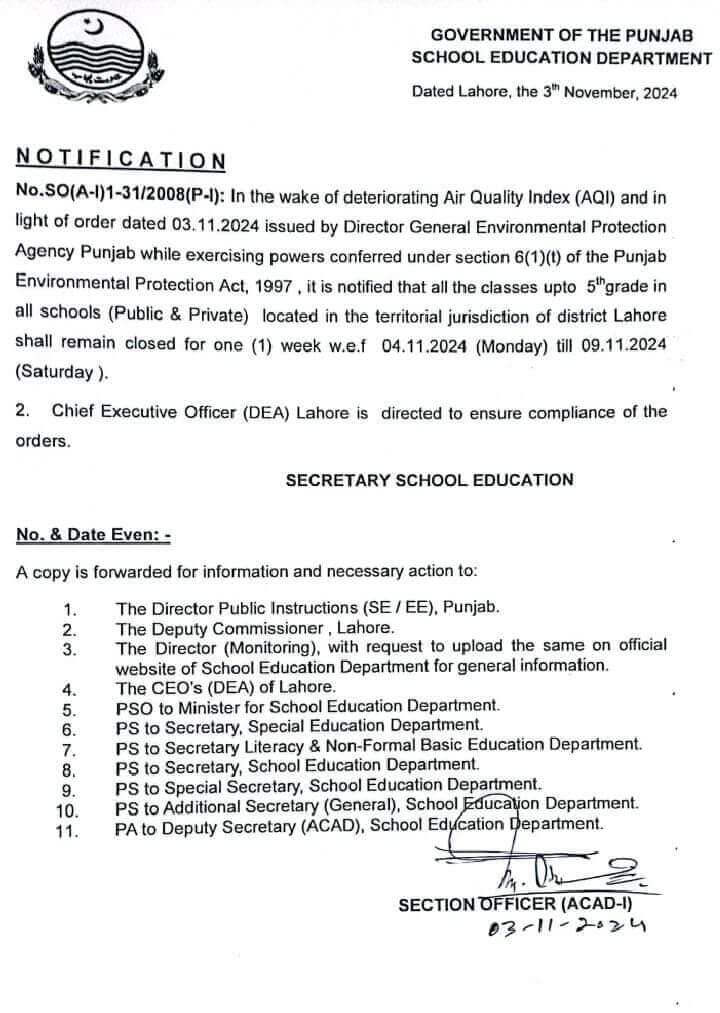Lahore Closes Primary Schools
The government of Punjab said it would close primary schools in Lahore for a week, from Monday, as an aggressive response to extremely hazardous air quality. That move was intended to guard the young population of Lahore from smog that the city had fallen into, raising the air pollution level at alarming proportions. The report showed the Air Quality Index reached above 1,000. This is the AQI considered “very dangerous” when it had risen beyond 300 units, said the authorities.
School Education Department – Punjab Portal
Understanding the Pollution Crisis
This city of over 14 million residents is facing a toxic mix of pollutants stemming from various sources. Low-grade diesel fumes, smoke from seasonal agricultural burning, and winter weather patterns have combined to create a smog crisis. According to data from IQAir, the air quality has consistently deteriorated with readings exceeding 1,000, marking a serious environmental emergency.
Lahore’s director environment protection, Jahangir Anwar, says the preventive closure was essential. “The weather forecasting for the next six days is such that there won’t be any respite from the wind, hence pollution won’t ease either,” he said. All primary schools—public, private, and special education institutions—are included up to 10 years of age.
Also Read: Maryam Nawaz Sharif Announce Subsidy For Farmer 40 Billion In Punjab

Health Risks to Children
Children are most susceptible to the harmful effects of air pollution on health. According to the World Health Organization, high levels of pollutants could result in severe health impacts: respiratory disease, heart disease, and strokes, among others. However, data actually revealed that PM2.5 was more than 40 times higher than the acceptable level set by WHO.
Children’s developing lungs along with higher respiratory rates, are also a risk because air pollution affects them differently as compared to adults. And considering all these hazards, Punjab senior minister Marriyum Aurangzeb made it clear that schools also need health measures in this regard. “Masks should be mandatory in schools, and we are keeping a close eye on children’s health in the senior classes,” she added.
Also Read: How To Get BISP Payment Through Jazzcash Account In November 2024
Government Programs and Social Reaction
The provincial government has done its best in terms of handling this kind of crisis regarding pollution. First off, there are new rules that are implemented in several hotspots around the city wherein tuk-tuks are prohibited from riding on such areas that have those two-stroke engines and restaurants that utilize barbecue and do not filter them out and even government offices as well as private companies had the scheme of working at home to half of their employees just to limit its exposure to the workers themselves.
The local government would reconvene next Saturday and determine if the shutdown has to be extended over time. In the short run, counters of smog are put up in hospitals measuring quality and its impact upon health.
Also Read: List of Successful People of All Districts Released by Green Tractor Scheme Through Lucky Draw
Air Pollution in South Asia
The Lahore problem of pollution is not something local but a part of an epidemic phenomenon that engulfs millions of kids living in South Asia today. According to UNICEF, nearly 600 million children in the region are exposed to harmful levels of air pollution. Half of childhood pneumonia deaths are associated with these environmental conditions. Research by the University of Chicago’s Energy Policy Institute suggests that life expectancy in Lahore is reduced by an average of 7.5 years when pollution exceeds safe levels.
Conclusion
This closure of primary schools in Lahore is a sharp reminder that the city and its residents urgently need proper environmental policies and public health measures. The battle against this pollution crisis needs to be fought hand in hand by the community members, policymakers, and health officials to safeguard the health of future generations. It is only when we come together that we can envision a healthier, safer environment for our children.
